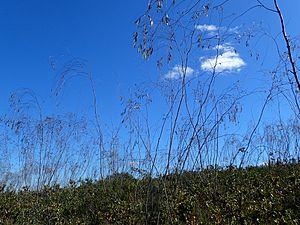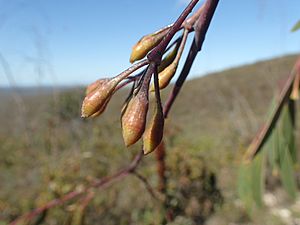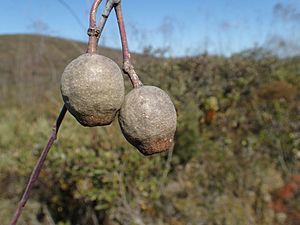Weeping gum facts for kids
Quick facts for kids Weeping gum |
|
|---|---|
 |
|
| Eucalyptus sepulcralis in the Fitzgerald River National Park | |
| Scientific classification | |
| Genus: |
Eucalyptus
|
| Species: |
sepulcralis
|
| Synonyms | |
|
Eucalyptus sepulcralis F.Muell. var. sepulcralis |
|
The Weeping gum (Eucalyptus sepulcralis), also called the weeping mallee, is a special type of eucalyptus plant. It is found only in a small part of Western Australia along the southern coast. This plant has thin stems with smooth bark. Its leaves are long and narrow. It produces pale yellow flowers and fruit shaped like barrels or urns.
Contents
What Does the Weeping Gum Look Like?
The Weeping gum is a slender mallee or a small tree. It usually grows to be about 3 to 8 meters (10 to 26 feet) tall. It has a graceful, weeping shape, meaning its branches hang downwards.
Bark and Leaves
The bark of the Weeping gum is smooth. It can be grey or a light pinkish-grey color. The leaves are thin and have a silvery look. They are a dull green color and grow in a scattered way along the branches.
Flowers and Fruit
This plant blooms between September and February. It produces groups of seven flower buds. These buds open into pale yellow flowers. After the flowers, the plant grows barrel-shaped or urn-shaped fruits.
Naming the Weeping Gum
The Weeping gum was first officially described by a botanist named Ferdinand von Mueller. He wrote about it in his book Eucalyptographia in 1882.
Why "Sepulcralis"?
The name sepulcralis comes from a Latin word. It means "belonging to a tomb." Von Mueller thought this tree would be perfect to plant near cemeteries. This is because its weeping branches look a bit like a weeping willow tree. The first sample of this plant was collected in 1880 near the Thomas River.
Where Does the Weeping Gum Grow?
The Weeping gum grows in a small area of Western Australia. It is found in the southern Kwongan heathland. This area is along the south coast, between the towns of Ravensthorpe and Hopetoun.
Its Home in Fitzgerald River National Park
You can find many Weeping gums in the Fitzgerald River National Park. Here, they grow in sandy soils on hillsides. In this low heathland area, the Weeping gum is a very common plant.
Is the Weeping Gum Protected?
The Western Australian Government's Department of Parks and Wildlife has looked at the Weeping gum. They have classified it as "not threatened." This means it is not currently in danger of disappearing.




